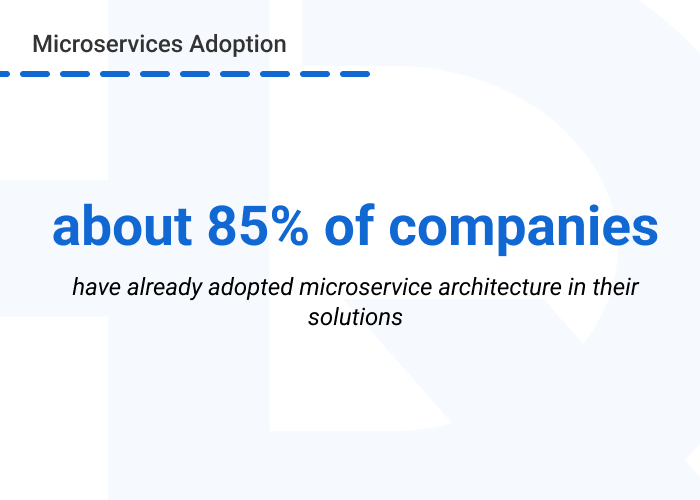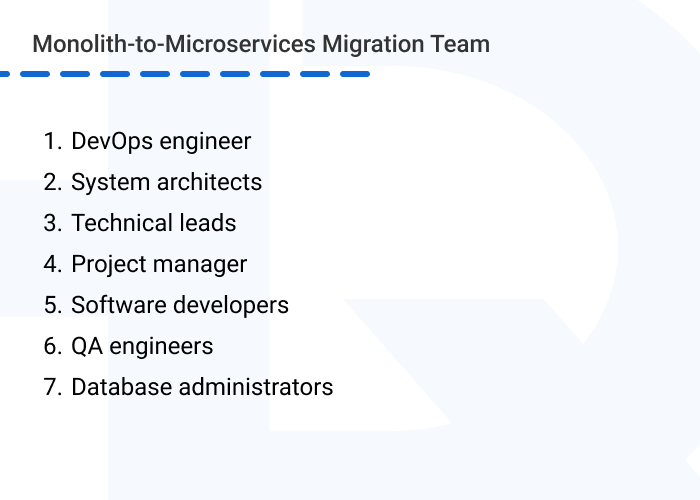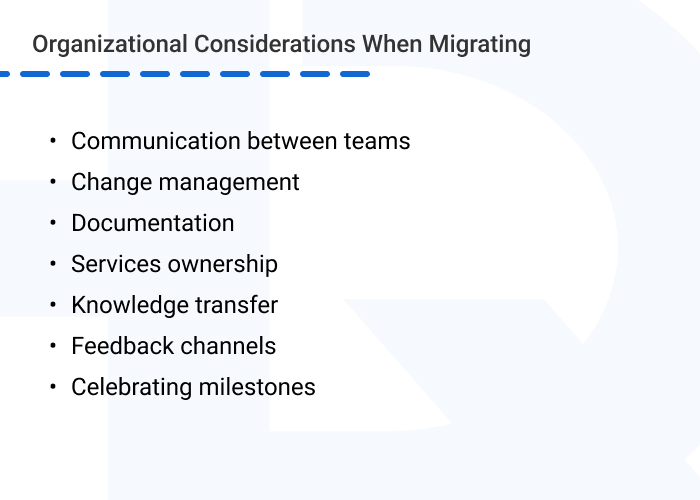Key Differences Between Monolith and Microservices
Limitations of Monolithic-to-Microservices Migration
Step-by-Step Monolith-to-Microservices Migration Plan
Case Studies and Examples of Monolithic-to-Microservices Migration
As a software development outsourcing company, we have frequently encountered scenarios where clients approach us with tightly coupled systems built on outdated technologies, where even a minor change could ruin the entire application.
Usually, such clients seek to scale their solutions and ensure the reliable handling of huge volumes of data. Upon closer examination, we have often realized that to meet the request, we had to change the system’s architecture to something more modern, flexible, and efficient. This is where monolith-to-microservices migration becomes invaluable.
In this comprehensive guide, we’ll describe a step-by-step monolith-to-microservices migration plan, so you can truly benefit from the migration, rather than end up with poor solution performance and wasted time and money.
Key Differences Between Monolith and Microservices
Limitations of Monolithic-to-Microservices Migration
Step-by-Step Monolith-to-Microservices Migration Plan
Case Studies and Examples of Monolithic-to-Microservices Migration
A monolithic architecture is an interconnected system with a single codebase and tightly coupled system components.
In contrast, microservices are separate modules responsible for particular tasks that require independent development and deployment. To exchange data and operate as a unified system, microservices communicate through well-defined APIs.

Thanks to their modular nature, each microservice can be modified separately without affecting other modules, thus speeding up feature development and allowing for smart resource allocation. This makes microservices a popular choice for complex and rapidly evolving applications, whereas a monolith architecture is more suitable for smaller projects.
For a detailed comparison of monolithic and microservices architectures, check out our “Monolithic vs Microservices” article.
System flexibility, independent development, and cost-effectiveness are among the primary reasons that 85% of companies, including some of HQSoftware’s customers, have already adopted microservice architecture in their solutions. Other benefits of monolith-to-microservices migration include:
To truly leverage the capabilities of a microservices architecture, it’s essential not to overlook some limitations you may face when moving from monolithic to microservices. Not considering these issues properly can lead to your company becoming one of the 45% that rate their migration as only partially successful or completely unsuccessful.

There’s no-size-fits-all solution, and the same applies to microservices. While this architecture can be appealing because of numerous advantages, your software might benefit more from a monolithic one. Therefore, you should first assess whether you genuinely need to convert from monolith to microservices.
If the answer is “yes,” be prepared that your monolithic-to-microservices migration will require significant time and upfront costs. While this architecture proves cost-effective in the long run, you will have to spend resources to establish a team, infrastructure, and data store for each microservice. And the longer the migration takes, the more resources you will need to allocate.
Speaking of migration times, there’s no average duration. The process can vary widely, taking anywhere from 6 months to 5 years to complete. With one of our clients, for example, migrating their LMS system took about four years. The timeline depends on your project’s complexity as well as the regularity of monolith system updates, which is another migration limitation.
During the migration of legacy applications to microservices, your monolithic app will still be running. If the migration is expected to be lengthy, you will probably want to consider updating the monolith periodically to maintain your market position. But it’s advisable not to do this.
Andrey Kazakevich
Head of Production
at HQSoftwareIf a monolithic system is being constantly changed, then its code will change as well. This can complicate the work of your team, as they’ll have to focus on locating inconsistencies and possibly modifying existing modules. As a result, microservices may not match the monolith, leading to errors and accumulation of technical debt. Therefore, we strongly recommend our customers freeze updates to the monolith system and only keep it operational.
It’s also necessary to establish smooth co-existence between the monolithic and microservices versions to avoid duplicated data, ensure reliable communication between components, and eliminate errors.
This is primarily a technical task that should be handled by your migration team. The key is to ensure that the specialists possess the necessary skills and expertise for migrating from monolithic architecture to microservices successfully.
Since every project is unique, it requires a unique approach to the migration, which will most likely not align with the “theory.” Your specialists should be flexible and have enough knowledge to establish the most efficient development strategy.
This is the strength of our specialists at HQSoftware. With extensive experience in migration projects, they’re adaptable thinkers who know how to transform theoretical migration patterns into working solutions tailored to the unique requirements of your project.
Thinking about migrating from monolith to microservices? We’re ready to help!HQSoftware has a team of skilled professionals ready to tackle the project. Let’s talk!
Anna Halias
Business Development Manager
Now that we’ve described the complexity involved in moving from monolithic to microservices, let’s examine the monolith-to-microservices roadmap.
Each project requires a customized migration plan, but they all follow these general steps:
To create a comprehensive plan, you should keep in mind several migration considerations, including assessing the current monolithic system and setting up a migration team.
The team should include a DevOps engineer, system architects, technical leads, a project manager, developers, QA engineers, and database administrators.
Together with specialists, you will be able to define into which microservices your system should be divided and choose relevant tools and technologies. Also, you should assess which components require improvements using more modern technologies or development approaches.

Based on the analysis of potential microservices structure, you can create a migration plan. It should include:
With a well-defined microservices migration plan, you will be able to control the transition process, manage project costs, and quickly respond to potential milestones, ensuring a smooth migration from a legacy application to microservices.
At this step, your team, led by system architects and a DevOps engineer, designs a microservices architecture. This includes:
One more thing to consider when migrating from monolithic architecture to microservices is that the process should be performed gradually. We recommend starting with an MVP that includes one or several vital services, or services with fewer dependencies. Therefore, at this step, it’s also important to prioritize services for extraction based on their business value and complexity.
For our projects at HQSoftware, we typically implement an agile development approach. Using that approach, we break down the development process into 1- to 2-week periods known as sprints. Each sprint aims to deliver a measurable app enhancement. After each sprint, we assess the outcome to determine what was done well and what needs to be optimized to boost the development process.
Andrey Kazakevich
Head of Production
at HQSoftwareThis approach enables us to prioritize work based on business value and urgency, quickly respond to customer feedback, and adjust the development strategy in line with changing project requirements.
The agile approach aligns particularly well with microservices migration, given their modular nature. Therefore, the development process begins with planning and assessing development sprints, including user stories, tasks, and objectives for the microservices being developed.
While the team plans sprints, a DevOps engineer sets up the necessary infrastructure and development environment, including IDEs, code repositories, and other development tools according to the migration plan.
During development, your team should pay close attention to implementing fault tolerance mechanisms within each microservice, to handle failures gracefully. This may include retries, circuit breakers, and fallback mechanisms.
Security should be a top priority at every level as well. So, employ security best practices, such as input validation, output encoding, and secure data transmission. Additionally, implement access controls, authentication, and authorization mechanisms to ensure that only authorized users and services can access sensitive data and functionality.
Also, keep in mind that your consumers will continue to use your solution during the monolith-to microservices migration. So, consider versioning your microservices APIs. Thus, you can manage changes and updates without breaking compatibility with existing users.
When converting monoliths to microservices, each microservice as well as the whole system should be thoroughly tested to avoid disruptions, data leakage, and low performance. Microservices should pass the following testing steps:

At this step, the expertise of a DevOps engineer becomes crucial to ensure a well-structured, automated, and efficient migration process.
First, they need to configure the infrastructure required for microservices deployment, including containerization and orchestration. Microservices are often, though not necessarily, deployed within containers, such as Docker, to facilitate deployment across different environments. They are also managed using container orchestration platforms, such as Kubernetes, to simplify load balancing, scaling, and rolling updates.
It’s also vital for your DevOps expert to establish continuous integration and continuous delivery (CI/CD) processes that allow for frequent and reliable releases. In this way, your team can build, test, and deploy microservices rapidly and consistently.
Once all microservices are deployed and you have successfully migrated a legacy application to microservices, you may think that’s it, but your journey is far from over.
After completing the software re-engineering process, you need to implement comprehensive monitoring tools to track the performance and health of your microservices. Use metrics, logs, and tracing to gain insights into how each microservice is functioning. Based on this data, you can make informed decisions to update and scale services that require additional resources independently. This approach enhances system performance and cost-efficiency, allowing you to fully leverage the benefits of microservices.
Andrey Kazakevich
Head of Production
at HQSoftwareMigrating from monolithic architecture to microservices isn’t rocket science. It typically doesn’t require inventing entirely new concepts. Instead, you and your team should focus on adapting general approaches to the specific needs of your business. And then, backed with skilled specialists, migrate gradually and carefully.
While your team is tackling technical challenges, you need to keep in mind some organizational considerations to make your monolith-to-microservices migration as smooth as possible:

By following these microservices migration steps and gaining the support of an experienced team, you can successfully convert a monolith to microservices, opening up numerous opportunities for future system growth.
Given the extensive roadmap, potential challenges, and significant time costs, is microservices migration worth a shot? There is no definitive answer, as it all depends on your project requirements and business specifics.
However, let’s explore some external and HQSoftware’s internal examples of moving from monolithic to microservices to understand how other companies benefited from the transition.
Maintaining smooth performance as data rapidly grows is a challenging task, especially in the financial industry, where data volumes can be enormous. This is one of the main reasons that about 34% of companies in the fintech sector employ microservices. Our client Evolv — a provider of audit services for self-managed super funds — turned to HQSoftware with the same challenge.
By implementing a microservices architecture, our team was able to migrate a legacy app to new technologies without loss of 500 GB of data and ensure reliable performance while financial document databases grow. This also significantly speeded up the audit process, reducing it from two weeks to 2-4 days.
When the monolith architecture of the globally known app Uber couldn’t support the rapid launch of new features, system updates, and bug fixes, the company looked toward cloud-based microservices.

By dividing the team into groups assigned to specific microservices, developers became experts in their respective areas of responsibility. This expertise enabled them to implement system updates more swiftly. Additionally, microservices provided the flexibility to scale rapidly, facilitating the company’s rapid growth.
Outdated technologies are the pain point of many companies, hindering their potential for business growth. To help our client align their real-time road-traffic safety system with changing needs, we decided to implement microservices, ensuring backward capability with previous app versions.
In this way, we were able to build each component with the most relevant tech stack to achieve maximum app productivity and ensure stability under high system loads.
As you see, the journey of migrating monoliths to microservices is a significant undertaking that requires a comprehensive understanding of all the nuances. From meticulous planning and agile development to robust testing and organizational considerations, each step is pivotal to your success. However, the rewards are substantial — increased flexibility, scalability, and efficiency.
At HQSoftware, we understand the complexities of this migration process, and our team of experts is ready to guide you through every migration step, from planning to deployment. Our DevOps, software, and QA engineers possess the expertise and adaptable thinking to design architecture that meets your requirements and to overcome the most tricky challenges, ensuring robust system performance.
So, feel free to contact us to embark on this exciting journey together, transforming your systems and propelling your organization into the future of microservices.

Lead Software Engineer
An experienced developer with a passion for IoT. Having participated in more than 20 Internet of Things projects, shares tips and tricks on connected software development.
We are open to seeing your business needs and determining the best solution. Complete this form, and receive a free personalized proposal from your dedicated manager.

Sergei Vardomatski
Founder